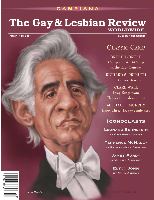

A
NTHONY
G
UY
P
ATRICIA
If Aschenbach Returned...
Death in Venice, California
by Vinton Rafe McCabe
The Permanent Press. 192 pages, $28.
N
OVELIST AND POET Vinton Rafe McCabe presents
a compact story that’s as compelling as it is discon-
certing. Though darkly comic and at times quite erotic,
this is not a light read. It is, however, an elegantly written and
artfully plotted gay novel that will make you think seriously
about art, relationships, obsessions, ageism, philosophy, pornog-
raphy, and sex.
At the center of
Death in Venice, California
is a character
named Jameson Frame, a fifty-year-old writer of some renown,
who has published exactly three works during his career: a pair
of novels titled
Pennyweight
and
The Antecedents
and a very
slim collection of poems called
On Scrimshaw and Others
. Be-
yond that, he’s a professor of creative writing at an unnamed
university in New York City. For all his modest success, Frame
suddenly finds himself dissatisfied with his life and disturbed by
the endless gray, cold days in Manhattan from November till
spring. So he heads west by commercial airplane and takes up
an extended residence at the posh Hotel des Bains in Venice
Beach, California.
Poised as he is on the liminal edge, it is difficult not to sus-
pect that something momentous is about to happen to Frame as
Death in Venice, California
unfolds in its leisurely but insistent
J
EAN
R
OBERTA
If Dorian Had Lived...
The Wilde Passions of Dorian Gray
by Mitzi Szereto
Cleis Press. 288 pages, $15.95
A
UTHOR Mitzi Szereto, who recently wrote a funny,
sexually explicit riff on Jane Austen’s
Pride and Prej-
udice
subtitled
Hidden Lusts
(2011), has now written
an erotic sequel to Oscar Wilde’s
The Picture of Dorian Gray
,
that gothic tale of a young man who magically trades places
with his portrait, which ages for him in the attic.
The Picture of Dorian Gray
, first serialized in a magazine in
1891, is a kind of literary experiment by a playwright who was
attempting a novel. Approximately one third of it follows the
moral degeneration of the attractive Dorian after his friend, the
painter Basil Hallward (who believes that everyone’s character
can be read in their face) asks him to pose for a painting. Basil’s
friend Lord Henry Wotton insists on meeting the young Adonis,
and then apparently corrupts the innocent Dorian by constantly
making witty comments that overturn conventional Victorian
morality. Another third of the book could be titled “The World
According to Lord Henry.” A final third is devoted to references
to historical figures and descriptions of the beautiful objects that
Dorian obsessively collects, including ecclesiastical garments
worn by Roman Catholic clergymen during Mass. Dorian en-
joys the perversity of owning these things as a nonbeliever.
Oscar Wilde’s real-life disgrace in the 1890s due to his reck-
less lawsuit against the Marquess of Queensbury (father of
Oscar’s younger friend and lover, “Bosie”)—followed by
Wilde’s conviction for sodomy, his prison term, and his early
death in exile in Paris—has made his story of the beautiful, dan-
gerous boy, Dorian Gray, seem like a prophesy. The book itself,
however, which lacks the coherence of most celebrated 19th-
century novels, can only hint at the nature of Gray’s degeneracy,
still an unspeakable topic in literature.
Mitzi Szereto has wisely avoided following the structure of
the original work. Instead, she has resurrected Dorian (who dies
upon destroying his hideous portrait) as a kind of immortal
predator. After a brief chapter in London in the 1890s in which
the original exchange of Dorian with his own image is summed
up, we next encounter Dorian in Paris in the 1920s playing sex
games with thinly disguised avatars of the writers F. Scott and
Zelda Fitzgerald and the painter Salvador Dali. Dorian is shown
to be a sensation seeker for whom nothing is off-limits, fully
pansexual with a special appetite for playing the dominant part-
ner who sometimes “tops from below.”
Dorian moves to Marrakesh in the 1940s in order to prevent
aging London acquaintances from recognizing him in Paris. The
influence of Lord Henry in some sense accompanies Dorian
wherever he goes, taking the form of aphorisms directly quoted
at the beginning of each chapter. Dorian eventually takes refuge
in a Peruvian monastery in the 1960s, where he finds a way to
cause trouble.
Despite Dorian’s usual preference for young men as bedfel-
lows, he is haunted by a recurring dream of a beautiful young
woman whose aura of innocent love shows his life in perspec-
tive. Perhaps he is haunted by his own hopes for salvation,
which confront him in New Orleans in the “present day” (post-
Hurricane Katrina). There he is recognized as a kindred soul by
a group of apparent goths who are actual vampires (shades of
Anne Rice). This close-knit group is led by a modern-day dandy
who reminds Dorian of his old mentor, Lord Henry, in the Lon-
don of over a century before. Unfortunately, the vampire-leader
is a man of few words who lacks the breezy wit of the original
Lord Henry.
The climax of Dorian’s long search for something he is only
dimly aware of wanting is as satisfying in Mitzi Szereto’s ver-
sion as it is in Oscar Wilde’s—possibly more so. Szereto’s use
of language is faithful to the original, even in the frequent sex
scenes. She’s a novelist who knows how to construct a coher-
ent plot, and she treats Oscar Wilde’s book with respect. So by
all means check out
The Wilde Passions of Dorian Gray
, espe-
cially if you’ve already read the original novel, or use it as an
excuse to read
The Picture of Dorian Gray
if you haven’t.
________________________________________________________
Jean Roberta is a widely published writer based in Regina, Saskatchewan.
March–April 2014
43










